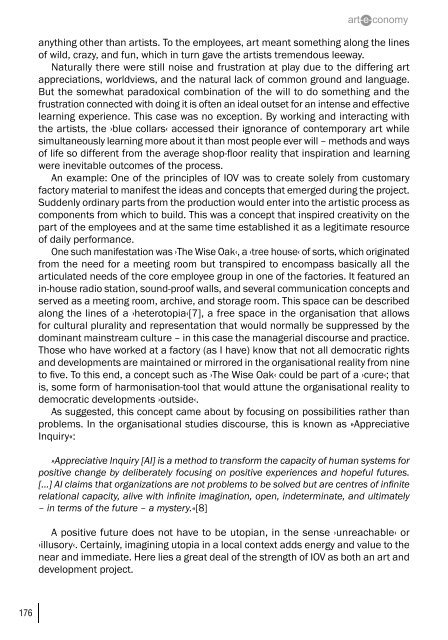art-e-conomy _ reader - marko stamenkovic
art-e-conomy _ reader - marko stamenkovic
art-e-conomy _ reader - marko stamenkovic
You also want an ePaper? Increase the reach of your titles
YUMPU automatically turns print PDFs into web optimized ePapers that Google loves.
176<br />
anything other than <strong>art</strong>ists. To the employees, <strong>art</strong> meant something along the lines<br />
of wild, crazy, and fun, which in turn gave the <strong>art</strong>ists tremendous leeway.<br />
Naturally there were still noise and frustration at play due to the differing <strong>art</strong><br />
appreciations, worldviews, and the natural lack of common ground and language.<br />
But the somewhat paradoxical combination of the will to do something and the<br />
frustration connected with doing it is often an ideal outset for an intense and effective<br />
learning experience. This case was no exception. By working and interacting with<br />
the <strong>art</strong>ists, the ›blue collars‹ accessed their ignorance of contemporary <strong>art</strong> while<br />
simultaneously learning more about it than most people ever will – methods and ways<br />
of life so different from the average shop-floor reality that inspiration and learning<br />
were inevitable outcomes of the process.<br />
An example: One of the principles of IOV was to create solely from customary<br />
factory material to manifest the ideas and concepts that emerged during the project.<br />
Suddenly ordinary p<strong>art</strong>s from the production would enter into the <strong>art</strong>istic process as<br />
components from which to build. This was a concept that inspired creativity on the<br />
p<strong>art</strong> of the employees and at the same time established it as a legitimate resource<br />
of daily performance.<br />
One such manifestation was ›The Wise Oak‹, a ›tree house‹ of sorts, which originated<br />
from the need for a meeting room but transpired to encompass basically all the<br />
<strong>art</strong>iculated needs of the core employee group in one of the factories. It featured an<br />
in-house radio station, sound-proof walls, and several communication concepts and<br />
served as a meeting room, archive, and storage room. This space can be described<br />
along the lines of a ›heterotopia‹[7], a free space in the organisation that allows<br />
for cultural plurality and representation that would normally be suppressed by the<br />
dominant mainstream culture – in this case the managerial discourse and practice.<br />
Those who have worked at a factory (as I have) know that not all democratic rights<br />
and developments are maintained or mirrored in the organisational reality from nine<br />
to five. To this end, a concept such as ›The Wise Oak‹ could be p<strong>art</strong> of a ›cure‹; that<br />
is, some form of harmonisation-tool that would attune the organisational reality to<br />
democratic developments ›outside‹.<br />
As suggested, this concept came about by focusing on possibilities rather than<br />
problems. In the organisational studies discourse, this is known as »Appreciative<br />
Inquiry«:<br />
»Appreciative Inquiry [AI] is a method to transform the capacity of human systems for<br />
positive change by deliberately focusing on positive experiences and hopeful futures.<br />
[…] AI claims that organizations are not problems to be solved but are centres of infinite<br />
relational capacity, alive with infinite imagination, open, indeterminate, and ultimately<br />
– in terms of the future – a mystery.«[8]<br />
A positive future does not have to be utopian, in the sense ›unreachable‹ or<br />
›illusory‹. Certainly, imagining utopia in a local context adds energy and value to the<br />
near and immediate. Here lies a great deal of the strength of IOV as both an <strong>art</strong> and<br />
development project.


